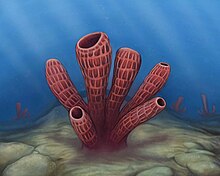Falospongia
| Falospongia Temporal range:
| |
|---|---|

| |
| Artist Restoration of Falospongia ramosa | |
| Scientific classification | |
| Kingdom: | Animalia |
| Phylum: | Porifera |
| Class: | Demospongiae |
| Order: | †Protomonaxonida |
| Family: | †Hazeliidae |
| Genus: | †Falospongia Rigby, 1986 |
| Species | |
Falospongia is a genus of sponge made up of radiating fronds, known from the Middle Cambrian Burgess Shale. Its name is derived from the Latin fala ("scaffold") and spongia ("sponge"), referring to the open framework of the skeleton. It superficially resembles but is monaxial.[2] 5 specimens of Falospongia are known from the Greater Phyllopod bed, where they comprise under 0.1% of the community.[3]
References[]
- ^ Rigby, J. K. (1986). "Sponges of the Burgess shale (Middle Cambrian), British Columbia". Palaeontographica Canadiana (2).
- ^ a b Rigby, J. K.; Collins, D. (2004). "Sponges of the Middle Cambrian Burgess Shale and Stephen Formations, British Columbia". ROM contributions in science. 1. ISBN 0-88854-443-X. ISSN 1710-7768.
- ^ Caron, Jean-Bernard; Jackson, Donald A. (October 2006). "Taphonomy of the Greater Phyllopod Bed community, Burgess Shale". PALAIOS. 21 (5): 451–65. doi:10.2110/palo.2003.P05-070R. JSTOR 20173022.
External links[]
- "Falospongia falata". Burgess Shale Fossil Gallery. Virtual Museum of Canada. 2011.
Categories:
- Burgess Shale fossils
- Protomonaxonida
- Burgess Shale sponges
- Prehistoric sponge genera
- Cambrian genus extinctions
- Demospongiae stubs
- Cambrian animal stubs
- Prehistoric sponge stubs